Text
WHAT WE DO

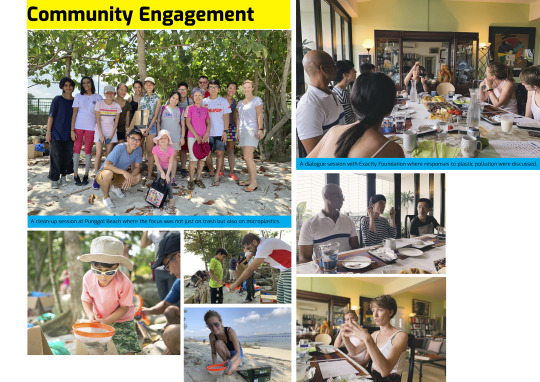
WHAT WE DO: Engage communities about our natural environment through visual, experiential and participatory works on two fronts: awareness and tangible social impact.
HOW WE DO IT: We translate research data, news, and views from the scientific community, the public, and the state into art and design projects that foster social participation.
WHO ARE WE: Operating as a social enterprise, Ayer Ayer is a team of artists, designers, biologists, and researchers working together within the space of art and science.
LEAD ARTIST: Ernest Goh
ART PARTNER: Brack
CONSERVATION PARTNER: Conservation International
MORE ABOUT AYER AYER: PDF
0 notes
Photo

Chat with us on social media: @ayerayerproject
Find us using: #ayerayerproject
Facebook: @ayerayerproject
Instagram: @ayerayerproject
Telegram: @ayerayerproject
0 notes
Text
LOVE TO BITS
by Ernest Goh

Artist Ernest Goh writes a letter to his synthetic love
Darling,
Did you have a good Chinese New Year? I assume you must have been very busy embracing the pomelos, biscuits, and cakes. It’s a profitable time but it must also have consumed so much of you.
Since new beginnings require just that…new beginnings, I would like to be honest with you. Your obsessive behaviour is making our relationship toxic. When I shop for groceries, not only do I see you clinging to every fruit and vegetable, you have even wrapped yourself around almost every single item on the shelf.
On the beach, I see you floating carelessly in the water and then wash up onto the shore in billions of tiny bits. Why do you never leave? You remain in the ocean for so long that marine animals suck you in, thinking you’re food! That’s the last straw for me!
Imagine how I feel when you invade the food chain and end up in my fish curry? Are you trying to make me sick – or kill me?
My friends and family love you so much that they think they can’t do without you. I’m not being jealous but can you give others a chance too? Glass, for example, is just as talented. She may be fragile but she doesn’t disintegrate and give us toxins. There’s Bamboo too. She’s tall and gangly but really very strong. Why not let them venture into people’s lives in a bigger way? You don’t have to be so possessive and be everywhere. Spreading yourself too thin will just lead you to breakdown into tiny pieces again. And guess who will have to clean up the mess bit by bit?
Can I give you some advice? Try to recharge and recycle more often and while you are at it reduce yourself. Don’t ruin your life by being cheap and useless. Be a reusable member of society and quit being self-servingly single-use. Always remember to offer yourself for a refill; otherwise you will end up buried in a landfill.
I want you to know that you’ve brought so much joy to my life. You were my toys in childhood, my stationary in school, my sugary pleasure in a bottle and at one time, almost my everything.

You made my world a better place. Your ability to make things light and flexible and not compromise on strength and clarity gave me conveniences I could only dream of.
So it really pains me to write this, but our relationship now is so much garbage and is suffocating my beloved home. We should see less of each other and find some room for more sustainable alternatives. I have to go now. I have to empty the trash.
Yours truly,
Ernest
#plastictrash#loveletter#oceantrash#microplastic plasticpollution lovetobits ayerayerproject photography
3 notes
·
View notes
Text
Word from the ‘Wart
By Li Li Chung

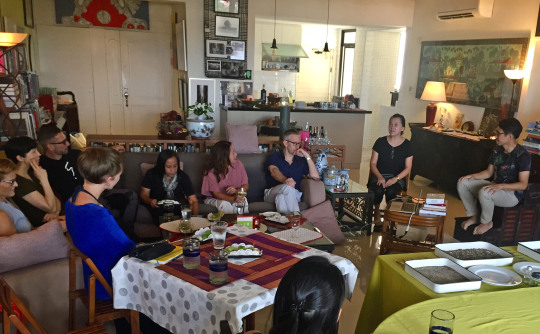
What is “green”? There’s the color green, which is as soothing as blue and opposite of fiery red.
Trees, foliage are mostly green. I like this subtitle – “Some Kind of Green” in Yahoo News’ Five Singapore statistics that stunned in 2018: “The Botanic Gardens are a UNESCO World Heritage site and almost half the city is under green cover, but we are undeniably wasteful. The 820 million plastic supermarket bags that Singapore uses each year could fill Gardens by the Bay 126 times over. Only about 2 percent of those bags are recycled.”
We can eat green: organic, vegan although I am not fond of eating only uncooked, cold food and I can only take so much of shriveled, air-dried vegetables and portobello mushrooms pretending to be hamburger buns.
This looks positive: “The Ministry of the Environment and Water Resources (MEWR) has designated 2019 as the Year Towards Zero Waste”. The statistic quoted: “Of the 1.6 million tonnes of domestic waste disposed of in 2017, one third consisted of packaging waste (includes plastics)”. Zero is good, right? To me, zero has an artificial “feel good” ring to it. If whatever you consume is burnt up/recycled 100%, net net it’s zero.
So, the official posture gives the impression that our problem in Singapore is mostly about not recycling enough. In fact, some argue that we don’t have a plastic waste problem, it’s only “11 percent of the total waste generated in Singapore in 2017”. What about the demand side, are we overconsuming plastic material? We would not have to recycle so much if we did not use so much in the first place (a stunning 2017 stat: 7.7 million tonnes of waste were produced in Singapore, a seven-fold increase from 40 years ago). The Zero Waste press release says: “Of the 1.6 million tonnes of domestic waste disposed of in 2017, one-third consisted of packaging waste (includes plastics)”. So we are advised to “... avoid single-use disposables where possible. Bring your own reusable bags, containers, and utensils. Choose products with less/green packaging”. That “green” word again. Green also means dissolving miraculously back into nature without harming it or any living thing.
But wait, there’s another color: blue. “Launch of the Singapore Blue Plan 2018!”, which is an impressive 230-page document on what to do about protecting marine life. At around the same time, a motion to charge for plastic bags was rejected in Parliament. A side thought on fighting diabetes: drink more water to cut back on sweet drinks. Connected topics?
Will we Singaporeans only get excited when microplastics show up inside our food? Ernest Goh’s Plasticity project talks about what we don’t see: the microplastic bits that marine life mistakes for food. Makes one think carefully about eating fish as a healthier alternative to meat. It is not conclusive that consuming fish meat carrying microplastics is directly harmful to humans, causing malfunction of our organs. Do we need such hard evidence before we buck up and do something about how much plastic material we are using and throwing away? It’s showing up: “Toxic bacteria found on small pieces of plastic trash from Singapore beaches”.
The tough question is how are we to behave? How do we stop using so much plastic? Is it enough, just shouting to get people to do the right thing? Should we be made to stop using so much plastic?
My favorite plastic gripe is the sale of bottled water (nearly 30% of discarded plastic items). I think we should stop selling them. But, in Singapore, it is not as easy as carrying water from home in your own bottle. It is about finding where in Singapore to refill them. And on that, we are sorely behind other countries. Not only are drinking water dispensers hard to find around Singapore, restaurants, and pubs will not refill your water bottle if you just want to walk in and ask. Nearly all beverage vendors in hawker centers/food courts charge 30cents for a cup of boiled water. Nowhere else except in Singapore, do I cringe at possibly getting scolded for asking for water from a food or beverage vendor. Would it be easy for the government to give a tax break to F&B businesses to allow them to give out free water? If we can ban chewing gum in one fell swoop, we can ban selling plastic bottled water, no?
What can we safely eat? That portobello mushroom bun doesn’t look so comical after all.
Li Li Chung is the founder of Exactly Foundation, a photography art residency based in Singapore. The Residency aims to enable professional photographers and visual journalists to produce works in Singapore that share and propagate the Foundation’s mission and vision. Importantly, the Foundation aims to dialogue and provide through private gatherings of viewers the experience of personal attainment of different perspectives and new ways of “looking” at community issues in Singapore. Secondly, the Residency allows for the Photographer to connect with other Singapore-based practitioners as well as other key professionals and thinkers for dialogue and feedback.
1 note
·
View note
Text
Picking up the Pieces
by Sarah Ichioka
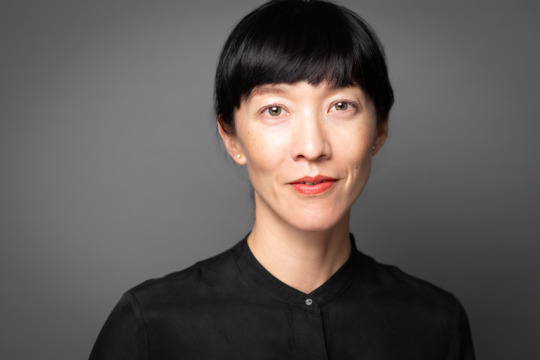
Sarah Ichioka writes the keynote essay for Plasticity, a photography series by visual artist Ernest Goh on plastic pollution found on Punggol Beach, Singapore. The photography series was made during Exactly Foundation Art Residency programme 2018-19.
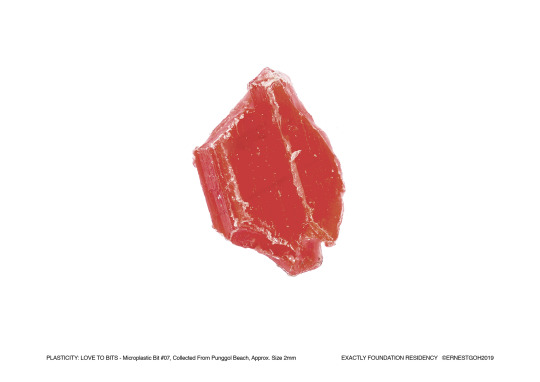

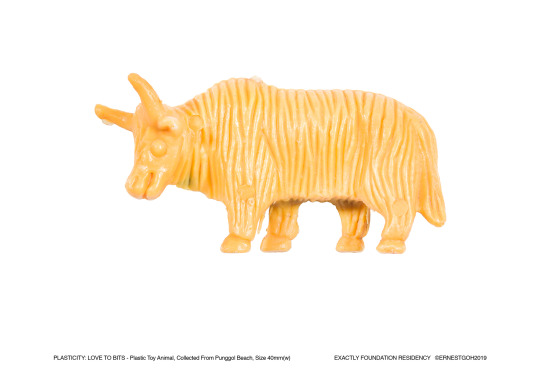
Sarah Ichioka writes the keynote essay for Plasticity, a photography series on microplastics and plastic pollution found on Singapore’s Punggol Beach, by visual artist, Ernest Goh for Exactly Foundation Art Residency programme.
On each page, a new object catches my eye; like jewels, like candy. I turn them over in my mind’s hand, admiring their lustrous surfaces, vivid colours.
My consumer-lust is aroused from its never too-deep sleep. That red shaft would make a stunning cocktail ring; that green streak, a tasty topping for a cake.
Mysterious figures appear on the white horizon. Our gazes meet. A wide-eyed soldier hoists his bayonet aloft. A wrinkled beast—a yak?—cocks a smirk in my direction. And wait, is that a… missile?
But then, suddenly, my fantasy falls to the ground. A bent red bottle cap, its curved white logo instantly recognisable. Intrigue flattens to disgust. These aren’t exotic goods whose heft begs handling; they’re nothing but so many tiny bits of trash.
++++
People who spend their time in or near the water—surfers, divers, sailors—are amongst the most passionate anti-plastic campaigners, because they see and feel the effects of ocean pollution first-hand. Photographer Ernest Goh traces the origin of his personal anti-plastic journey to a wave-borne shopping bag that smothered his face. Other friends—a married couple—have shared with me their experience of snorkeling and watching pieces of discarded plastic float by—including food packaging designed by the husband’s very own company.
Even when mediated through photos or videos, for folks more frequently in shopping malls than in the surf, there is a visual aspect of the plastic pollution crisis that imparts an immediate sense of accountability. That object I see lodged in the sea turtle’s nose is most certainly a plastic straw, just like the one I sucked my kopi peng through this morning; that cigarette lighter inside the ribcage of the albatross chick’s carcass is unmistakably the same item that my husband hides beneath his cufflinks and credit card receipts.
This visually self-evident character differentiates our plastic pollution crisis from some of the concurrent, compound emergencies we humans have created. Take our carbon pollution crisis: I have to believe climate scientists when they tell me that my holiday flights hasten the thawing of the permafrost. Or our nitrogen pollution crisis: I have to trust hydrology experts when they say that runoff from fertiliser used to grow my lunch causes massive downstream dead zones. In such cases, obfuscation and denial are easier to sustain, whether by ourselves, by industry lobbyists or by politicians.
The comparative legibility of our plastic pollution crisis might suggest that it is more politically “solvable” than some of these other potentially existential, yet less easily illustrated crises we face.
Having accepted our culpability, how might we begin to atone for it?
One response offers an appealing narrative of consumer activism: maybe we can (mindfully) shop our way out of this mess, by opting for more durable, reusable items? Certainly making a habit of carrying a water flask, a canvas shopping bag, and a set of bamboo eating utensils is a decent place to start, not least as a conversation starter and signal of one’s concern.
Perhaps the problem can be solved if we try our best to #recyclebetter, as the current Singaporean campaign urges? Or is recycling merely a “fig leaf on consumerism” as Jane Muncke, Director of Zurich's Food Packaging Forum puts it?
Maybe we should just tidy up a bit more? When I was a kid, my father would take me for an annual volunteer clean-up of the coast near our California home. Ending the day with sore muscles and a sack full of bullet casings (from a nearby shooting range), cigarette butts, condoms, deodorant rollers, and crumbling chunks of styrofoam was deeply satisfying to me, as tangible evidence of my personal concern and participation. Last year, I chaperoned my daughter’s preschool class on a similar clean-up outing to Singapore’s East Coast Park. This time, I felt rather less contented, overwhelmed by the seeming futility of our attempts, observing casual littering by park users and the floating trash ready to wash ashore as soon as we’d cleared our patch of beach.
As it happens, in about the same timespan as that between my leaving university and becoming a mother, the global volume of plastic production doubled. The same report that documents this leap estimates that global industries have produced 8,300 million metric tons of plastic since 1950. 6,400 million metric tons of this plastic—that’s roughly 100 times the weight of the concrete used to build the Three Gorges Dam, the world’s largest manmade structure—have become waste, nearly 80% of which sits in landfills or our natural environment. Less than 10% has been recycled, while the remainder has been incinerated (as has until recently been standard practice in Singapore).
In Singapore itself, plastic waste per capita has increased nearly 20 percent over the last 15 years. Looking at this country’s plastic bag usage alone, about 2,640 bags are thrown away every three seconds.
Projecting forward current production and pollution trends, another report predicts by 2050 our oceans could contain more plastics than fish (by weight), while the plastics industry itself could consume 15% of our annual carbon budget, and 20% of global oil production.
While our plastic pollution crisis is so overwhelmingly large, it is also mind-twistingly small. Here I mean small in the sense probed by Goh’s photographs: the scale of the microplastics, and now nano-plastics, whose presence has been documented in nearly every corner of our terrestrial and aquatic habitats, and which are now entering our food chain, with unknown, but potentially toxic effects.
The proximity of Goh’s plastic-strewn Punggol beach to a seafood restaurant seems apt. We study the food chain and hydrological cycles as concepts in school, but when most of us enter the “real” world we conveniently forget the practical implications of our systemic connections with the rest of nature.
Understanding the interconnected nature of plastic pollution’s causes and effects is a kind of reawakening. It destabilises the narrative that sees human culture as separate from the natural environment. That story of separation has been a necessary psychological cover for the exploitation of living systems that underpins nearly every aspect of our current economic and political order. Once we remember that ecocide is suicide, will we continue it?
Have we trashed Earth beyond habitability? No problem, we’ll just migrate to Mars, as deckhands or stowaways on a tech oligarch’s spaceship. But wait, turns out we’ve already trashed outer space too. Parts of broken satellites and rockets currently amount to over 8 million kilos of space waste. Rather like ocean plastics, the larger bits of space waste are fragmenting into smaller and smaller pieces, which interfere with digital communications and might even hinder future spacecraft launches.
So let’s turn our eyes back to our damaged and depleted, yet still living and magnificent planet.
“Reduce, reuse, recycle, refuse”? Yes of course, let’s do that. But politely declining plastic straws and rinsing our Coke bottles is simply not enough. Also—and in my view, more importantly—we must act not just as individual consumers but collectively, as concerned citizens and social beings.
With this in mind, let me leave you with an alternative “4 Rs” to consider:
Rebel: Let us raise our voices together, unashamed to share our grief, rage, and disgust at the devastation that our overconsumption-based society has unleashed all around us, clogging our commons and poisoning our sources of sustenance. Let’s insist on better, for ourselves, and for the complex living systems upon which our survival depends.
Root: Let us ground the solutions to our plastic pollution crisis in the lived history and culture of Singapore and its region*. What local wisdom and practices, from karung guni men, to metal tiffins, to banana leaf wrappers and beyond, might be usefully revisited for contemporary use? How might technological and behavioural innovations ground themselves in Singaporeans’ particular resources and values?
Relate: Let us decipher and then communicate the underlying systems that perpetuate this global crisis. Let’s understand for example, who benefits from the otherwise dangerous proliferation of plastics, and how they exert influence on policies and regulations. Let’s study why some national and local governments have taken action to solve the plastic pollution crisis more swiftly than others, and what successful changes early actors have made. Let’s explore how our plastic pollution crisis intersects with other economic, environmental and social systems.
And finally, Regenerate: Let us draw inspiration from the natural world to craft materials and manufacturing cycles that are truly waste-free. Let’s design, build, and inhabit systems that proactively repair past damage, clean up our rubbish, and co-create the conditions for our living world to flourish. It will be a beautiful sight.
Sarah Mineko Ichioka is a Singapore-based urbanist, curator and writer. She leads Desire Lines, a consultancy for environmental, cultural, and social-impact organisations. www.sarahichioka.com
*Ernest Goh’s MA thesis at Goldsmiths followed a similar vein, looking to historical urban successes to inspire contemporary applications. In Goh’s case, the water fountains of ancient Rome inspired the idea for new public water fountains for Singapore, which will be piloted as a part of this project at ADEX 2019.
++++++
Further reading:
https://www.plasticpollutioncoalition.org/
https://polymerdatabase.com/polymer%20classes/Plastics%20Industry%20Facts.html
https://polymerdatabase.com/Polymer%20Brands/Plastic%20Manufacturers.html
https://www.opensecrets.org/lobby/lookup.php (tip: enter “plastic” in the Issue search field)
https://www.edb.gov.sg/en/our-industries/energy-and-chemicals.html
http://singapore-companies-directory.com/categories/singapore_plastics.htm
1 note
·
View note
Photo

Ayer Ayer Project is an ecologically-engaged art project by photographer and visual artist Ernest Goh who has been looking into the social stranglehold of plastic since 2009. The artist’s photography art practice, with a particular focus in natural history and wildlife, prompted an interest in plastic pollution when he learned that the ocean’s marine environment became the frontline of the war against plastic trash. This led the artist to investigate the complex relationship between animal, human and plastic.
1 note
·
View note
Photo

Partnering ADEX2019 to present Ayer Ayer Project in April 2019. We will be working to show
PLASTICITY - the result of artist Ernest Goh’s photography residency with Exactly Foundation.
Love To Bits, a participatory artwork to engage visitors about microplastic pollution.
Ayer Ayer Fountains, a public art and social innovation project created to offer clean drinking water to displace the single-use bottled water.
And a dialogue-performance in collaboration artist Kei Franklin and socially engaged art platform��BRACK.
2 notes
·
View notes
Photo
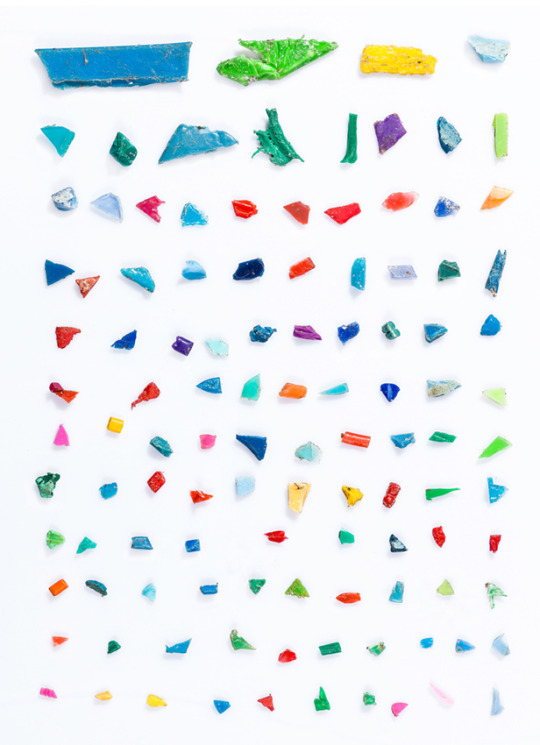
Image caption: Image from the series Plasticity: Love To Bits, microplastic fragments collected from Punggol Beach, Singapore, 2018 and 2019.
1 note
·
View note
Photo
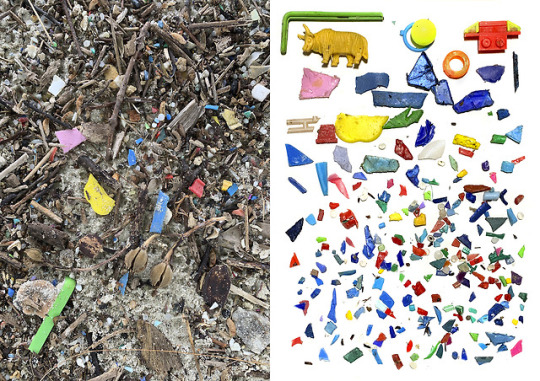
PLASTICITY - Photography residency with Exactly Foundation, Nov 2018.
In physics, plasticity describes the deformation of a material by an applied force. Since its first appearance in 1907, synthetic plastic has forced a permanent change in human cultures and commerce globally. We are all addicted to plastic and the great convenience it has brought us but along with that, plastic has also brought about catastrophic environmental pollution and potentially harmful effects on human health.
1 note
·
View note
Photo

About the Artist
Ernest Goh is a visual artist whose work focuses on ecological relationships. His fascination with the natural world began as a boy at his grandmother’s rural kampung(village) in Singapore in the 1980s, wading in streams looking for fish and jumping into bushes searching for spiders.
His animal portraits have been published in The Fish Book (2011), Cocks (2013, republished as Chickens in the US in 2015), and The Gift Book (2014). He presented an exhibition, Breakfast at 8 Jungle at 9 (Objectifs – Centre for Photography and Film, Singapore, 2015), exploring the famed British explorer and naturalist Alfred Russel Wallace’s time in Singapore and the Asian region in the 1850s.
Ernest has received the Discernment Award at the ICON de Martell Cordon Bleu Awards, Singapore (2012) and the Sony World Photography Award (2013). He is also the creative director of The Animal Book Co., an independent outfit that works with animal welfare groups through art and design.
Previously a photojournalist with The Straits Times, Ernest has freelanced for wire agencies and international publications such as Smithsonian and Monocle. His documentary work has been published in Beyond Masks (2004), a book documenting the experiences of healthcare workers inside Singapore’s largest hospital during the SARS outbreak, and in the multimedia piece Altered Land (2009), which showcased his four-year documentation of the aftermath of the 2004 Indian Ocean tsunami in Aceh, Indonesia.
Ernest’s work has been commissioned by and installed at the Lee Kong Chian Natural History Museum, Singapore, collected by the Multimedia Art Museum Moscow, and also resides in corporate, public and private collections.
1 note
·
View note